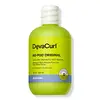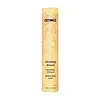What's inside
What's inside
 Key Ingredients
Key Ingredients

 Benefits
Benefits

 Concerns
Concerns

 Ingredients Side-by-side
Ingredients Side-by-side

Water
Skin ConditioningCetyl Alcohol
EmollientIsopropyl Palmitate
EmollientBehentrimonium Chloride
PreservativeLaureth-4
EmulsifyingGlycerin
HumectantPPG-3 Benzyl Ether Myristate
EmollientVitis Vinifera Seed Oil
EmollientCitric Acid
BufferingCocamidopropyl Betaine
CleansingCocos Nucifera Oil
MaskingEthylhexylglycerin
Skin ConditioningHydroxypropyltrimonium Hydrolyzed Corn Starch
Isopropyl Alcohol
SolventMenthol
MaskingPentaerythrityl Tetra-Di-T-Butyl Hydroxyhydrocinnamate
AntioxidantPolyquaternium-7
Sodium Chloride
MaskingTetrasodium EDTA
Tocopherol
AntioxidantTrisodium Ethylenediamine Disuccinate
Phenoxyethanol
PreservativeSodium Benzoate
MaskingParfum
MaskingCitronellol
PerfumingGeraniol
PerfumingWater, Cetyl Alcohol, Isopropyl Palmitate, Behentrimonium Chloride, Laureth-4, Glycerin, PPG-3 Benzyl Ether Myristate, Vitis Vinifera Seed Oil, Citric Acid, Cocamidopropyl Betaine, Cocos Nucifera Oil, Ethylhexylglycerin, Hydroxypropyltrimonium Hydrolyzed Corn Starch, Isopropyl Alcohol, Menthol, Pentaerythrityl Tetra-Di-T-Butyl Hydroxyhydrocinnamate, Polyquaternium-7, Sodium Chloride, Tetrasodium EDTA, Tocopherol, Trisodium Ethylenediamine Disuccinate, Phenoxyethanol, Sodium Benzoate, Parfum, Citronellol, Geraniol
Water
Skin ConditioningSodium Lauroyl Sarcosinate
CleansingSodium Cocoyl Isethionate
CleansingCoco-Betaine
CleansingDisodium Laureth Sulfosuccinate
CleansingSodium Lauryl Sulfoacetate
CleansingGlyceryl Distearate
EmollientParfum
MaskingDivinyldimethicone/Dimethicone Copolymer
Carbomer
Emulsion StabilisingDecyl Glucoside
CleansingPhenyl Trimethicone
Skin ConditioningPolyquaternium-10
Amodimethicone
PPG-5-Ceteth-20
EmulsifyingHydroxyethyl Behenamidopropyl Dimonium Chloride
Ozokerite
Emulsion StabilisingGlycereth-26
HumectantPanthenol
Skin ConditioningSodium Hydroxide
BufferingPolyquaternium-7
Sodium Chloride
MaskingC12-13 Pareth-23
CleansingC12-13 Pareth-3
EmulsifyingC11-15 Pareth-7
EmulsifyingGlycerin
HumectantLaureth-9
EmulsifyingTrideceth-12
EmulsifyingCitric Acid
BufferingHippophae Rhamnoides Seed Oil
Skin ProtectingEthylhexylglycerin
Skin ConditioningBenzophenone-4
UV AbsorberTocopheryl Acetate
AntioxidantAloe Barbadensis Leaf Juice
Skin ConditioningBenzyl Alcohol
PerfumingDehydroacetic Acid
PreservativePhenoxyethanol
PreservativeChlorhexidine Dihydrochloride
AntimicrobialPotassium Sorbate
PreservativeSodium Benzoate
MaskingButylphenyl Methylpropional
PerfumingLimonene
PerfumingHydroxycitronellal
PerfumingHydroxyisohexyl 3-Cyclohexene Carboxaldehyde
MaskingWater, Sodium Lauroyl Sarcosinate, Sodium Cocoyl Isethionate, Coco-Betaine, Disodium Laureth Sulfosuccinate, Sodium Lauryl Sulfoacetate, Glyceryl Distearate, Parfum, Divinyldimethicone/Dimethicone Copolymer, Carbomer, Decyl Glucoside, Phenyl Trimethicone, Polyquaternium-10, Amodimethicone, PPG-5-Ceteth-20, Hydroxyethyl Behenamidopropyl Dimonium Chloride, Ozokerite, Glycereth-26, Panthenol, Sodium Hydroxide, Polyquaternium-7, Sodium Chloride, C12-13 Pareth-23, C12-13 Pareth-3, C11-15 Pareth-7, Glycerin, Laureth-9, Trideceth-12, Citric Acid, Hippophae Rhamnoides Seed Oil, Ethylhexylglycerin, Benzophenone-4, Tocopheryl Acetate, Aloe Barbadensis Leaf Juice, Benzyl Alcohol, Dehydroacetic Acid, Phenoxyethanol, Chlorhexidine Dihydrochloride, Potassium Sorbate, Sodium Benzoate, Butylphenyl Methylpropional, Limonene, Hydroxycitronellal, Hydroxyisohexyl 3-Cyclohexene Carboxaldehyde
Ingredients Explained
These ingredients are found in both products.
Ingredients higher up in an ingredient list are typically present in a larger amount.
Citric Acid is an alpha hydroxy acid (AHA) naturally found in citrus fruits like oranges, lemons, and limes.
Like other AHAs, citric acid can exfoliate skin by breaking down the bonds that hold dead skin cells together. This helps reveal smoother and brighter skin underneath.
However, this exfoliating effect only happens at high concentrations (20%) which can be hard to find in cosmetic products.
Due to this, citric acid is usually included in small amounts as a pH adjuster. This helps keep products slightly more acidic and compatible with skin's natural pH.
In skincare formulas, citric acid can:
While it can provide some skin benefits, research shows lactic acid and glycolic acid are generally more effective and less irritating exfoliants.
Most citric acid used in skincare today is made by fermenting sugars (usually from molasses). This synthetic version is identical to the natural citrus form but easier to stabilize and use in formulations.
Read more about some other popular AHA's here:
Learn more about Citric AcidEthylhexylglycerin (we can't pronounce this either) is commonly used as a preservative and skin softener. It is derived from glyceryl.
You might see Ethylhexylglycerin often paired with other preservatives such as phenoxyethanol. Ethylhexylglycerin has been found to increase the effectiveness of these other preservatives.
Glycerin is already naturally found in your skin. It helps moisturize and protect your skin.
A study from 2016 found glycerin to be more effective as a humectant than AHAs and hyaluronic acid.
As a humectant, it helps the skin stay hydrated by pulling moisture to your skin. The low molecular weight of glycerin allows it to pull moisture into the deeper layers of your skin.
Hydrated skin improves your skin barrier; Your skin barrier helps protect against irritants and bacteria.
Glycerin has also been found to have antimicrobial and antiviral properties. Due to these properties, glycerin is often used in wound and burn treatments.
In cosmetics, glycerin is usually derived from plants such as soybean or palm. However, it can also be sourced from animals, such as tallow or animal fat.
This ingredient is organic, colorless, odorless, and non-toxic.
Glycerin is the name for this ingredient in American English. British English uses Glycerol/Glycerine.
Learn more about GlycerinParfum is a catch-all term for an ingredient or more that is used to give a scent to products.
Also called "fragrance", this ingredient can be a blend of hundreds of chemicals or plant oils. This means every product with "fragrance" or "parfum" in the ingredients list is a different mixture.
For instance, Habanolide is a proprietary trade name for a specific aroma chemical. When used as a fragrance ingredient in cosmetics, most aroma chemicals fall under the broad labeling category of “FRAGRANCE” or “PARFUM” according to EU and US regulations.
The term 'parfum' or 'fragrance' is not regulated in many countries. In many cases, it is up to the brand to define this term.
For instance, many brands choose to label themselves as "fragrance-free" because they are not using synthetic fragrances. However, their products may still contain ingredients such as essential oils that are considered a fragrance by INCI standards.
One example is Calendula flower extract. Calendula is an essential oil that still imparts a scent or 'fragrance'.
Depending on the blend, the ingredients in the mixture can cause allergies and sensitivities on the skin. Some ingredients that are known EU allergens include linalool and citronellol.
Parfum can also be used to mask or cover an unpleasant scent.
The bottom line is: not all fragrances/parfum/ingredients are created equally. If you are worried about fragrances, we recommend taking a closer look at an ingredient. And of course, we always recommend speaking with a professional.
Learn more about ParfumPhenoxyethanol is a preservative that has germicide, antimicrobial, and aromatic properties. Studies show that phenoxyethanol can prevent microbial growth. By itself, it has a scent that is similar to that of a rose.
It's often used in formulations along with Caprylyl Glycol to preserve the shelf life of products.
Polyquaternium-7 is a light to clear colored liquid. It is commonly found in haircare products for its film-forming and anti-static properties.
According to a manufacturer, it is a non-paraben and specially developed for negatively charged surfactant systems. This makes it a great hairstyle holder and helps to improve wet hair detangling without adding buildup.
Sodium Benzoate is a preservative. It's used in both cosmetic and food products to inhibit the growth of mold and bacteria. It is typically produced synthetically.
Both the US FDA and EU Health Committee have approved the use of sodium benzoate. In the US, levels of 0.1% (of the total product) are allowed.
Sodium benzoate works as a preservative by inhibiting the growth of bacteria inside of cells. It prevents the cell from fermenting a type of sugar using an enzyme called phosphofructokinase.
It is the salt of benzoic acid. Foods containing sodium benzoate include soda, salad dressings, condiments, fruit juices, wines, and snack foods.
Studies for using ascorbic acid and sodium benzoate in cosmetics are lacking, especially in skincare routines with multiple steps.
We always recommend speaking with a professional, such as a dermatologist, if you have any concerns.
Learn more about Sodium BenzoateChances are, you eat sodium chloride every day. Sodium Chloride is also known as table salt.
This ingredient has many purposes in skincare: thickener, emulsifier, and exfoliator.
You'll most likely find this ingredient in cleansers where it is used to create a gel-like texture. As an emulsifier, it also prevents ingredients from separating.
There is much debate on whether this ingredient is comedogenic. The short answer - comedogenic ratings don't tell the whole story. Learn more about comegodenic ratings here.
The concensus about this ingredient causing acne seems to be divided. Research is needed to understand if this ingredient does cause acne.
Scrubs may use salt as the primary exfoliating ingredient.
Learn more about Sodium ChlorideWater. It's the most common cosmetic ingredient of all. You'll usually see it at the top of ingredient lists, meaning that it makes up the largest part of the product.
So why is it so popular? Water most often acts as a solvent - this means that it helps dissolve other ingredients into the formulation.
You'll also recognize water as that liquid we all need to stay alive. If you see this, drink a glass of water. Stay hydrated!
Learn more about Water